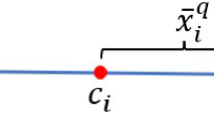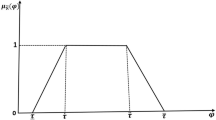Abstract
Data are usually stored in databases with temporal components and quantitative values. In temporal databases, each data item has its own exhibition periods. In other word, early items have a longer lifespan. Item lifespan must be considered in mining process for fair and accurate results. Otherwise, extracted patterns may not exhibit the associations of items correctly enough. Some efficient algorithms have been thus proposed for extracting fuzzy association rules from quantitative temporal transactions. However, the membership functions affect rule discovery. Learning or tuning the membership functions for fuzzy temporal association rules mining is thus necessary. In this paper, we combined fuzzy temporal mining concepts into a fuzzy-evolutionary approach and designed an efficient fuzzy temporal-evolutionary mining process based on bees algorithm to find suitable membership functions for fuzzy temporal mining problems before searching for temporal frequent itemsets and fuzzy associations. Experimental results show that the proposed method exhibits good performance with respect to the effectiveness of the obtained solution.



















Similar content being viewed by others
References
Agrawal R, Srikant R (1994) Fast algorithms for mining association rules in large databases. The 20th international conference on very large data bases, pp 487–499
Alcalá-Fdez J, Alcalá R, Gacto MJ, Herrera F (2009) Learning the membership function contexts for mining fuzzy association rules by using genetic algorithms. Fuzzy Sets Syst 160(7):905–921
Antonelli M, Ducange P, Marcelloni F (2014) A fast and efficient multi-objective evolutionary learning scheme for fuzzy rule-based classifiers. Inf Sci 283(1):36–54
Asadollahpour-chamazi M, Minaei-Bidgoli B, Nasiri M (2013) Deriving support threshold values and membership functions using the multiple-level cluster-based master-slave IFG approach. Soft Comput 17(7):1227–1239
Brijs T, Swinnen G, Vanhoof K, Wets G (1999) Using association rules for product assortment decisions: a case study. In: Proceedings of the fifth international conference on knowledge discovery and data mining, pp 254–260
Cai G, Li S, Chen S (2010) Mining fuzzy association rules by using nonlinear particle swarm optimization. In: Cao B, Wang G, Chen S, Guo S (eds) Quantitative logic and soft computing 2010. Advances in intelligent and soft computing, vol 82. Springer, Berlin
Castellani M, Pham QT, Pham DT (2012) Dynamic optimisation by a modified bees algorithm. Proc Inst Mech Eng Part I J Syst Control Eng 226(7):956–971
Chan CC, Au WH (1997) Mining fuzzy association rules. In: Proceedings of the conference on information and knowledge management, Las Vegas, pp 209–215
Chan KCC, Au WH (1998) An effective algorithm for discovering fuzzy rules in relational databases. IEEE Int Conf Fuzzy Syst 2:1314–1319
Chen L, Bhowmick SS, Li J (2006) Mining temporal indirect associations. In: Proceedings of the 10th Pacific-Asia conference, PAKDD 2006, Singapore, LNCS 3918, Springer, Berlin, pp 425–434
Chen C-H, Hong T-P, Tseng VS, Lee C-S (2007) A genetic-fuzzy mining approach for items with multiple minimum supports. Fuzzy systems IEEE international conference, pp 1–6
Chen C-H, Tseng V-S, Hong T-P (2008) Cluster-based evaluation in fuzzy-genetic data mining. IEEE Trans Fuzzy Syst 16(1):249–262
Chen C-H, Hong T-P, Tseng VS (2009) An improved approach to find membership functions and multiple minimum supports in fuzzy data mining. Expert Syst Appl 36:10016–10024
Chen C-H, Hong T-P, Lee YC (2011a) A multiple-level genetic-fuzzy mining algorithm. In: 2011 IEEE international conference on fuzzy systems, FUZZ-IEEE 2011, Taipei, pp 278–282
Chen CH, Hong TP, Lin SB (2011b) Mining fuzzy temporal knowledge from quantitative transactions. In: Proceedings 2011 international conference on system science and engineering. Macao, pp 405–409
Chen CH, Lan GC, Hong TP, Lin SB (2016) Mining fuzzy temporal association rules by item lifespans. Appl Soft Comput 41:265–274
Fahmy AA, Kalyoncu M, Castellani M (2012) Automatic design of control systems for robot manipulators using the bees algorithm. Proc Inst Mech Eng Part I J Syst Control Eng 226(4):497–508
Guney K, Onay M (2010) Bees algorithm for interference suppression of linear antenna arrays by controlling the phase-only and both the amplitude and phase. Expert Syst Appl 37:3129–3135
Hong TP, Kuo CS, Chi SC (1999) Mining association rules from quantitative data. Intell Data Anal 3(5):363–376
Hong T, Kuo C, Chi S (2001) Trade-off between time complexity and number of rules for fuzzy mining from quantitative data. Int J Uncertain Fuzziness Knowl Based Syst 9(5):587–604
Hong TP, Lin KY, Chien BC (2003) Mining fuzzy multiple-level association rules from quantitative data. Appl Intell 18(1):79–90
Hong T-P, Chen C-H, Wu Y-L (2004) Using divide-and-conquer GA strategy in fuzzy data mining. In: Proceedings of ninth international symposium on computers and communications. ISCC 2004, vol 1, pp 116–121
Hong T-P, Lee YC, Wu MT (2005) Using master-slave parallel architecture for GA-fuzzy data mining. In: The 2005 IEEE international conference on systems, man, and cybernetics, pp 3232–3237
Hong T-P, Chen C-H, Wu Y-L (2006) A GA-based fuzzy mining approach to achieve a trade-off between number of rules and suitability of membership functions. Soft Comput 10(11):1091–1101
Hong T-P, Chen C-H, Tseng VS (2009a) Genetic-fuzzy data mining techniques. Encyclopedia of complexity and systems science, pp 4145–4160
Hong T-P, Tung Y-F, Wang S-L, Wu M-T, Wu Y-L (2009b) An ACS-based framework for fuzzy data mining. Expert Syst Appl 36(9):11844–11852
Hong T-P, Tung Y-F, Wang S-L, Wu Y-L, Wu M-T (2012) A multi-level ant-colony mining algorithm for membership functions. Inf Sci 182(1):3–14
Hong T-P, Lee Y-C, Wu M-T (2014) An effective parallel approach for genetic-fuzzy data mining. Expert Syst Appl 41(2):655–662
Kaya M (2006) Multi-objective genetic algorithm based approaches for mining optimized fuzzy association rules. Soft Comput 10:578–586
Kaya M, Alhajj R (2003) A clustering algorithm with genetically optimized membership functions for fuzzy association rules mining. In: The IEEE international conference on fuzzy systems, pp 881–886
Kuok CM, Fu AW-C, Wong MH (1998) Mining fuzzy association rules in databases. ACM SIGMOD Rec 27(1):41–46
Lee C-H, Lin C-R, Chen M-S (2001) On mining general temporal association rules in a publication database. In: Proceedings 2001 IEEE international conference on data mining, San Jose, CA, pp 337–344
Lee C-H, Chen M-S, Lin C-R (2003) Progressive partition miner: an efficient algorithm for mining general temporal association rules. IEEE Trans Knowl Data Eng 15(4):1004–1017
Lee Y-C, Hong T-P, Wa T-C (2008) Multi-level fuzzy mining with multiple minimum supports. Expert Syst Appl 34:459–468
Matthews SG, Gongora MA, Hopgood AA, Ahmadi S (2012) Temporal fuzzy association rule mining with 2-tuple linguistic representation. In: The IEEE international conference on fuzzy systems, pp 1–8
Matthews SG, Gongora MA, Hopgood AA, Ahmadi S (2013) Web usage mining with evolutionary extraction of temporal fuzzy association rules. Knowl Based Syst 54:66–72
Özbakır L, Tapkan P (2011) Bee colony intelligence in zone constrained two-sided assembly line balancing problem. Expert Syst Appl 38:11947–11957
Ozden B, Ramaswamy S, Silberschatz A (1998) Cyclic association rules. In: Proceedings of 14th international conference on data engineering, Orlando, FL, 1998, pp 412–421
Parodi A, Bonelli P (1993) A new approach of fuzzy classifier systems. In: Proceedings of fifth international conference on genetic algorithms. Morgan Kaufmann, Los Altos, pp 223–230
Pham DT, Ghanbarzadeh A, Koc E, Otri S, Rahim S, Zaidi M (2005) The bees algorithm. Technical note, Manufacturing Engineering Centre, Cardiff University, UK
Rudzinski F (2016) A multi-objective genetic optimization of interpretability-oriented fuzzy rule-based classifiers. Appl Soft Comput 38:118–133
Ruz GA, Goles E (2013) Learning gene regulatory networks using the bees algorithm. Neural Comput Appl 22(1):63–70
Xu W, Zhou Z, Pham DT, Liu Q, Ji C, Meng W (2012) Quality of service in manufacturing networks: a service framework and its implementation. Int J Adv Manuf Technol 63(9–12):1227–1237
Author information
Authors and Affiliations
Corresponding author
Ethics declarations
Conflict of interest
The authors declare that there is no conflict of interests regarding the publication of this paper.
Additional information
Communicated by V. Loia.
Rights and permissions
About this article
Cite this article
Chamazi, M.A., Motameni, H. Finding suitable membership functions for fuzzy temporal mining problems using fuzzy temporal bees method. Soft Comput 23, 3501–3518 (2019). https://doi.org/10.1007/s00500-018-3010-7
Published:
Issue Date:
DOI: https://doi.org/10.1007/s00500-018-3010-7




